Fears about 'massive mosquito' in Chaiyaphum alleviated
In the northeastern province of Chaiyaphum, a recent incident involving the presence of long-legged insects has been creating a stir among the residents of Kok Sa Ard, Nong Bua Rawe district. The insects, resembling mosquitoes or spiders, have sparked fear and concern in the community, with some fearing they might pose a danger to children or the community.
However, an investigation conducted by the local office of the Department of Disease Prevention and Control has confirmed that these insects are, in fact, crane flies. Contrary to popular belief, crane flies do not bite or sting and are harmless to humans.
What are Crane Flies?
Adult crane flies live only a few days to two weeks and are found worldwide, often in damp environments such as riverbanks, grasslands, open forests, and gardens. They measure about 25-38 mm long with very long legs, making them easily distinguishable from mosquitoes, which are much smaller (3-7 mm) and have a proboscis used for blood feeding.
Crane flies belong to the family Tipulidae and are part of the Nematocera group of flies, which typically have elongated bodies and many-segmented antennae. The larvae, often called leatherjackets, hatch from eggs laid in damp areas and mostly feed on decaying plant material, though some species may be carnivorous or cause damage to lawns or crops.
Misconceptions and Clarifications
The misconception about these insects being giant mosquitoes stems from their physical resemblance. Adult crane flies primarily do not feed; some may sip nectar or dew, but they mainly live off fat stored from their larval stage and survive only 10-15 days to reproduce.
Dr Taweechai Visanuyothin, the director of the local office of the Department of Disease Prevention and Control, urged the public not to panic about the presence of crane flies. He emphasized that they do not cause a nuisance to people and are not capable of biting or transmitting diseases.
Benefits of Crane Flies
Interestingly, crane fly larvae can benefit the ecosystem by preying on mosquito larvae. This means that despite their initial appearance, these insects play a crucial role in controlling the mosquito population.
For more detailed information about crane flies, including their lifecycle, biology, and different species such as the range crane fly (Tipula simplex), reputable sources include entomology pages like Britannica, educational extensions such as the University of Arizona Extension, and scientific summaries on general fly anatomy and life cycles (e.g., Wikipedia's fly entry). Informal insights and observations can also be found on social platforms like TikTok, which show their appearance and behavior.
If you have any further questions or concerns about crane flies or any other health-related issues, the public can contact the Department of Disease Control hotline on 1422. It's always important to stay informed and not let misconceptions create unnecessary fear or concern.
Investigations have confirmed that crane flies, despite resembling mosquitoes, are harmless to humans, and there's no need for concern in health-and-wellness. In fact, crane fly larvae can be beneficial, as they prey on mosquito larvae, helping to control the mosquito population in sports, such as outdoor activities and mixed-martial-arts, where mosquitoes can be a nuisance.




